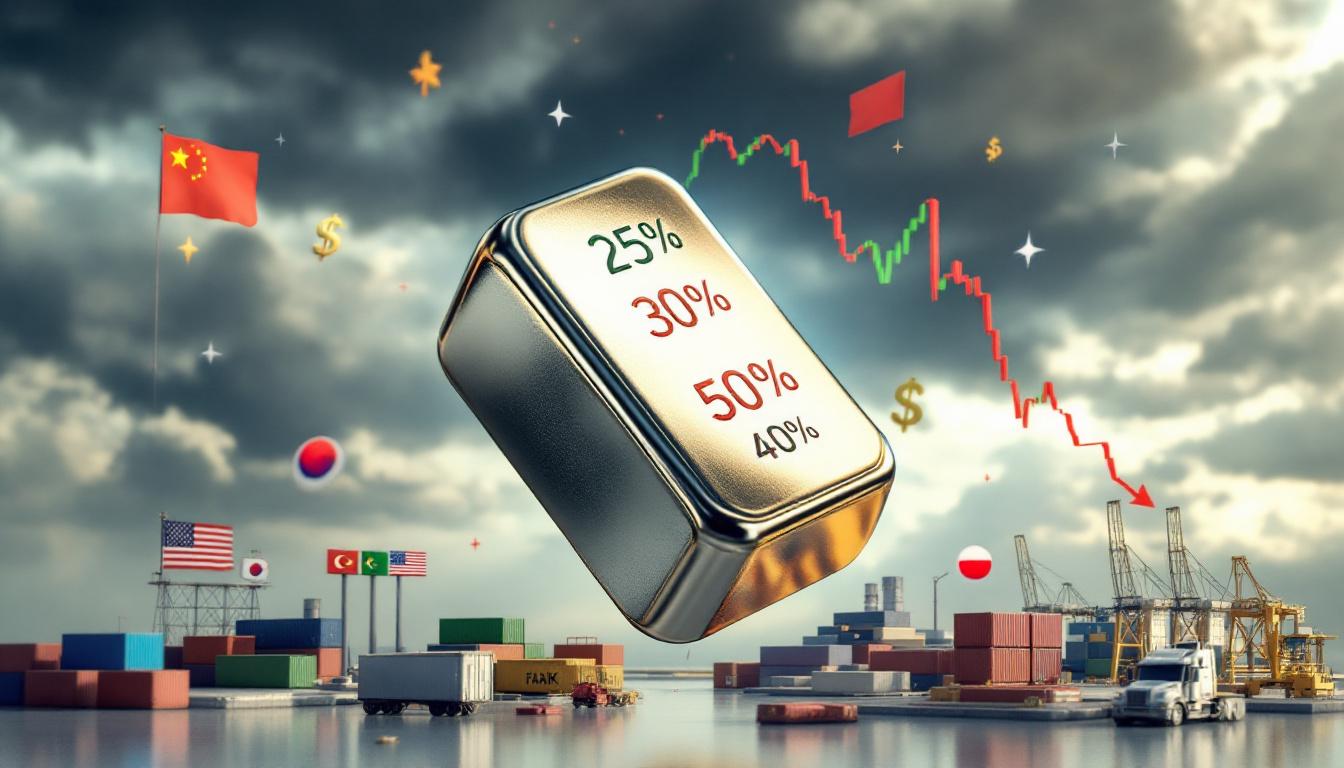Silver has emerged as a vital strategic resource in 2025. Its role as silver as a critical mineral in 2025 is evident in technological advancements and green energy solutions. Governments worldwide now classify silver as indispensable for economic and industrial growth. In fact, discussions about its evolution can be enriched by insights on historical trends in gold and silver investments.
Silver’s unique electrical conductivity and antimicrobial properties make it irreplaceable in advanced electronics and medical applications. Solar panels, electric vehicles, and defence technologies now depend extensively on silver. With growing industrial consumption, efforts for addressing critical mineral shortages for clean energy are intensifying worldwide.
Global industrial demand now accounts for 55% of silver consumption, with the renewable energy sector driving substantial usage. The U.S. Department of Energy reported that solar panel manufacturing consumes around 80 million ounces annually. Such consumption underscores silver’s growing role as silver as a critical mineral in 2025 and reinforces the metal’s strategic importance.
Silver’s production is primarily a byproduct of base metal mining operations. Seventy-two percent of global supply is secured alongside copper, zinc, and lead extraction. Only 12 major pure silver deposits exist, mostly in politically unstable regions. These challenges add geopolitical risks that echo themes explored in the critical minerals race amid global tensions.
High-grade silver veins now demand deeper, costlier extraction methods, as noted by Sean Kukun. The industry has seen a decline in average ore grades from 15 g/t in 2000 to just 8 g/t in 2025. Such challenges call for a deeper understanding of the market dynamics reflected in key trends in the gold and silver market.
Capital intensity remains a significant barrier to increasing silver production. New mining projects require between $5-7 billion in capital expenditure. Additionally, extending timelines for resource approval is a pressing challenge. Regulatory hurdles, like the four-year delay at Fresnillo PLC’s Juanicipio mine, underscore that throwing money at the problem is not a solution.
Recent experiences show that even a $100 billion injection would not instantly resolve production bottlenecks. Permitting complications and extended exploration-to-production pipelines—from 7 years in the 1990s to over 15 years today—exacerbate supply challenges. This dynamic reinforces silver’s role as silver as a critical mineral in 2025.
Expert Quote:
"Throwing money at the scarcity issue won't work. High-grade silver veins once economically mined at surface now require deeper, costlier extraction." – Sean Kukun
The market has shifted significantly over the last two decades. Photography once consumed nearly two-thirds of all silver production. However, digital advancements have reduced demand in that sector. Today, industrial sectors account for most of consumption, presenting both challenges and opportunities for long-term value.
The solar sector, growing at 19% year-over-year in 2024, consumes roughly 140 million ounces of silver annually. In addition, electric vehicle production drives further demand, with each vehicle requiring between 25-50 grams of silver in electronics. This shift further cements silver’s status as silver as a critical mineral in 2025.
Supply-demand imbalances have intensified. While industrial usage climbs rapidly, supply struggles due to declining ore grades and strict permitting regimes. TD Securities’ 2024 report warned that "silver is sleepwalking into a squeeze." Meanwhile, COMEX silver inventories dropped 42% between 2020 and 2025, reaching only 120 million ounces.
The paper-to-physical ratio in the futures market reached an unprecedented 250:1 in 2025. This high ratio creates significant delivery risks should investors start demanding physical silver. Despite a 100% price rise from $18/oz in 2022 to $36/oz in 2025, silver retains untapped potential for growth.
Technical analysis shows that silver’s lengthy consolidations can disrupt market stability. For instance, the 1970–1980 bull market saw a dramatic 2,400% increase in silver prices. With historical data supporting such trends, investor sentiment continues to be a potent force behind price surges. Perfect timing for silver is crucial for those looking to capitalise on these shifts.
Historical comparisons reveal that key bull market breakouts were preceded by extended consolidation phases. Technical analysts observe that no significant resistance has yet formed above the $50-$100 range. As such, breaking through these thresholds may cause dramatic price movements. Peter K’s "cup and handle" pattern indicates targets between $180-$300/oz after a breakout.
Monetary debasement also supports the potential for triple-digit silver prices. Between 2019 and 2025, M2 money supply growth weakened major fiat currencies, reinforcing silver’s allure as silver as a critical mineral in 2025. Investors increasingly view the gold-silver ratio as a benchmark for potential gains. A ratio reverting from today’s 85:1 to historical averages suggests significant undervaluation.
Several catalysts may accelerate this revaluation. Consider these factors:
- Futures market delivery demands – where supply constraints force physical settlement.
- Geopolitical disruptions – particularly in major producing regions such as Mexico and Peru.
- Institutional investment flows – large-scale buying can rapidly deplete inventories.
- Retail investment surges – evidenced by coordinated online buying groups.
The potential for a silver squeeze intensifies as these elements converge.
Understanding silver valuation is vital for investors. The detailed process involves assessing net asset value (NAV) based on mineral inventories. Resources are categorised as measured, indicated, or inferred, with varying valuation multiples reflecting the risk profile. This methodology is particularly relevant when navigating risks in junior mining investments.
Investors generally follow a three-step approach:
- Calculate NAV based on resource confidence levels.
- Assess project progression—permits, financing, and engineering studies are key.
- Apply the appropriate discount rates based on the project's stage.
A comprehensive table summarises these factors:
• Inventory category and grade quality
• Permitting status advantages
• Financing and cost structures
• Development stage discount factors
Legendary investor Eric Sprott has noted that silver equities may offer 3x leverage in mature bull markets—a critical consideration for those studying mineral valuation in detail.
Dolly Varden Silver exemplifies effective market positioning. Since 2019, the company’s market capitalisation grew from $20 million to $450 million by 2025. Their strategy focused on consolidating a high-grade district-scale resource base in Canada. This approach highlights the importance of targeted growth strategies in a competitive landscape.
Their growth model included several key steps:
- Identifying and expanding high-grade resource bases.
- Attracting specialized institutional investors instead of retail ones.
- Implementing technology-driven exploration, which improved discovery results by 37% from 2023 to 2025.
- Executing strategic M&A acquisitions to consolidate resource positions.
Sean Kukun summarised the approach: "We target 20-year mine life assets to attract institutional investors." The company’s performance reinforces silver’s relevance as silver as a critical mineral in 2025, especially for institutions seeking long-term value.
Expert Approach Highlighted:
Combining field exploration excellence with strategic boardroom decisions.
– Sean Kukun
What exactly does a 'silver squeeze' mean?
A silver squeeze occurs when physical shortages in the market cause prices to surge due to delivery constraints versus paper claims. Traders must buy physical silver to settle futures contracts. This can result in rapid price increases when inventories are overwhelmed. Such solar and geopolitical factors can quickly intensify this squeeze.
What could trigger future silver squeezes?
Potential triggers include:
- Increased futures delivery demands as contract settlements shift from cash to physical metal.
- Geopolitical disruptions in major mining regions.
- Major institutional shifts towards holding physical silver.
- Retail investor surges driving rapid market moves.
Silver’s historical monetary significance further underpins its role as silver as a critical mineral in 2025. The metal’s long-standing use in monetary systems and as a hedge during financial crises continues to attract both institutional and retail investors. New market perspectives from global market perspectives provide further context into these dynamics.
In today’s evolving economic landscape, silver’s dual appeal as an industrial asset and a monetary safeguard is more prominent than ever. With ongoing shifts in investor behaviour and global policy, silver remains central to discussions about critical minerals. This ongoing relevance ensures its continued prominence in investment discussions throughout 2025 and beyond.
Want to Profit from the Next Major Silver Discovery?
Discover how you can leverage silver's growing importance as a critical mineral with Discovery Alert's proprietary Discovery IQ model that instantly notifies investors about significant ASX mineral discoveries. Explore why major mineral discoveries can lead to substantial returns by visiting Discovery Alert's dedicated discoveries page and position yourself ahead of the market with actionable insights.




